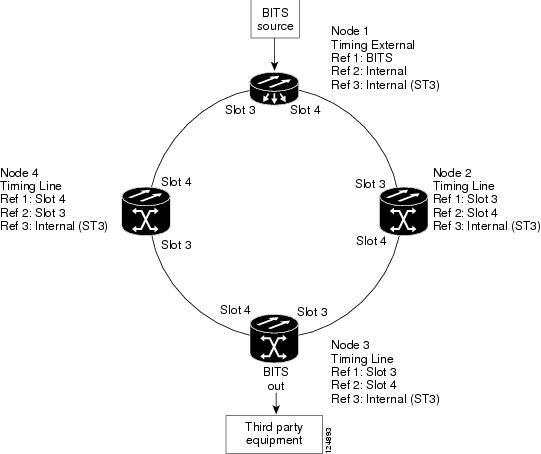

-
Cisco ONS 15310-CL Reference Manual, Release 6.0
-
Chapter 1, Shelf Assembly Hardware
-
Chapter 2, Card Reference
-
Chapter 3, Card Protection
-
Chapter 4, Cisco Transport Controller Operation
-
Chapter 5, Security
-
Chapter 6, Timing
-
Chapter 8, SONET Topologies
-
Chapter 7, Circuits
-
Chapter 10, Alarm Monitoring and Management
-
Chapter 9, Management Network Connectivity
-
Appendix A, Specifications
-
Appendix B, Administrative and Service States
-
Appendix C, Network Element Defaults
-
About this Manual
-
Table Of Contents
6.3 Synchronization Status Messaging
Timing
This chapter provides information about Cisco ONS 15310-CL SONET timing. To provision timing, refer to the Cisco ONS 15310-CL Procedure Guide.
Chapter topics include:
•
Synchronization Status Messaging
6.1 Timing Parameters
Node Timing parameters must be set for each ONS 15310-CL. Each ONS 15310-CL independently accepts its timing reference from one of three sources:
•
The building integrated timing supply (BITS) port on the ONS 15310-CL.
•
An OC-N port on the ONS 15310-CL. The port is connected to a node that receives timing through a BITS source.
•
The internal ST3 clock on the CTX card.
You can set ONS 15310-CL timing to one of three modes: external, line, or mixed. If timing is coming from the BITS port, set ONS 15310-CL timing to external. If the timing comes from an OC-N and DS1 port, set the timing to line. Typical ONS 15310-CL networks have the following timing configurations:
•
One node is set to external. The external node derives its timing from a BITS source wired to the CTX port. The BITS source derives its timing from a primary reference source (PRS) such as a Stratum 1 clock or global positioning satellite (GPS) signal.
•
The other nodes are set to line. The line nodes derive timing from the externally timed node through the DS1 port and OC-N trunk (span) port.
You can set three timing references for each ONS 15310-CL. The first two references are typically two BITS-level sources, or two line-level sources optically connected to a node with a BITS source. The third reference is usually assigned to the internal clock provided on every ONS 15310-CL CTX card. However, if you assign all three references to other timing sources, the internal clock is always available as a backup timing reference. The internal clock is a Stratum 3 (ST3), so if an ONS 15310-CL node becomes isolated, timing is maintained at the ST3 level.
The CTC Maintenance > Timing > Report tabs show current timing information for an ONS 15310-CL, including the timing mode, clock state and status, switch type, and reference data.
CautionMixed timing allows you to select both external and line timing sources. However, Cisco does not recommend its use because it can create timing loops. Use mixed timing mode with caution.
6.2 Network Timing
Figure 6-1 shows an example of an ONS 15310-CL network timing setup. Node 1 is set to external timing. One reference is set to BITS, the two references are set to internal. The BITS output pins on the CTX cards of Node 3 provide timing to outside equipment, such as a digital access line multiplexer.
Figure 6-1 ONS 15310-CL Timing Example
6.3 Synchronization Status Messaging
Synchronization status messaging (SSM) is a SONET protocol that communicates information about the quality of the timing source. SSM messages are carried on the S1 byte of the SONET line layer. They enable SONET devices to automatically select the highest quality timing reference and to avoid timing loops.
SSM messages are either Generation 1 or Generation 2. Generation 1 is the first and most widely deployed SSM message set. Generation 2 is a newer version. If you enable SSM for the ONS 15310-CL, consult your timing reference documentation to determine which message set to use. Table 6-1 and Table 6-2 show the Generation 1 and Generation 2 message sets.

 Feedback
Feedback
